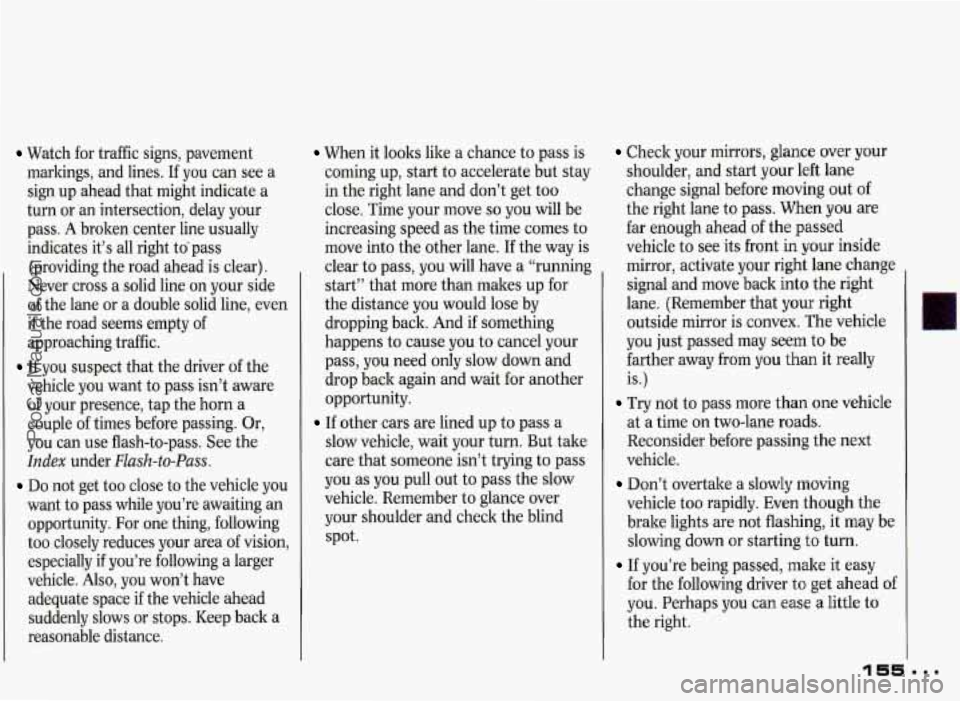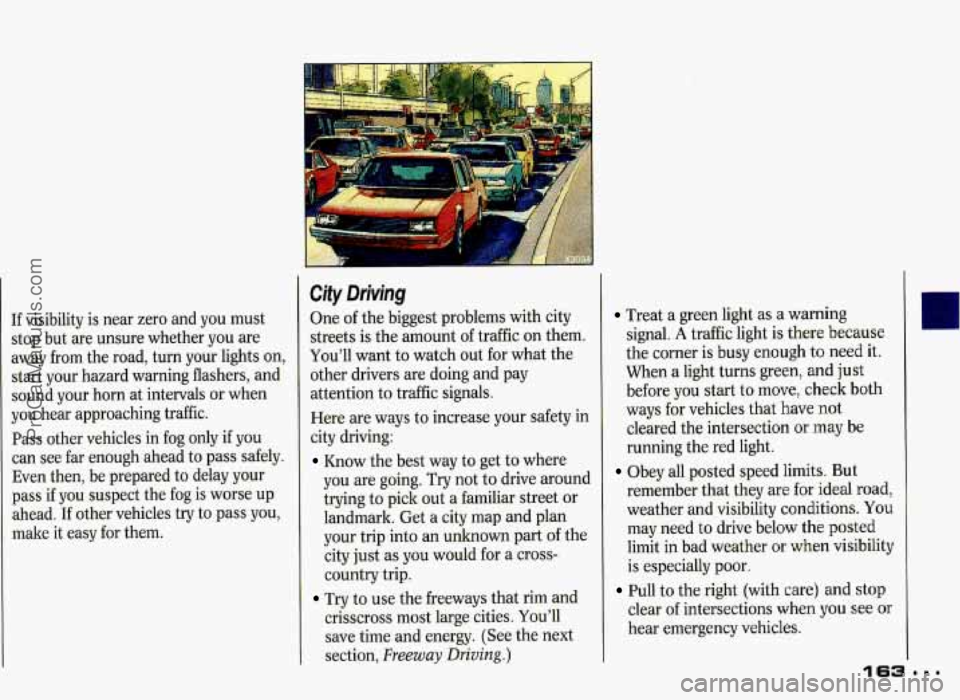1993 PONTIAC GRAND-PRIX horn
[x] Cancel search: hornPage 7 of 338

How to Use this Manual
Vehicle Symbols (CQNT.)
These symbols are on some of your
controls:
Windshield
WiperlWasher
Windshield Defroster
Rear Window Defogger
Ventilating Fan
Power Window
These symbols are used on warning and
indicator lights:
Engine Coolant - Fd
Temperature .HccF
Battery Charging
System
Fuel
Engine Oil Pressure
Brake
Anti-Lock Brakes
Here are some other symbols you may
see:
Fuse
Trunk Release
Lighter
Horn
Speaker
Hood Release
ProCarManuals.com
Page 70 of 338

(Continued)
is not hlly in P (Park) with the
parking brake firmly set. Your
vehicle can roll. Don’t leave pur
vehicle when the engine is running
unless you have to. If you’ve left
the engine running, the vehicle can
move suddenly. You or others
could be injured. To be sure your
vehicle
won’t move, even when
you’re on fairly level ground, always
set your parking brake and move
the
shift lever to P (Park).
If you are parking on a hill, or if
you’re pulling a trailer, also see the
In&x under Parking on Hills or
Towing a Tnzileu.
.- i ,- - . I.
Horn
You can sound the horn by pressing the
horn symbols on your steering wheel.
Tilt Steering Wheel (omow
A tilt steering wheel allows you to
adjust the steering wheel before
you
drive. You can also raise it to the
highest level
to give your legs more
room when you exit and enter the
vehicle.
To tilt the wheel, hold the steering
wheel and pull the lever.
Move the
steering wheel to
a comfortable level,
then release the lever to
lock the wheel
in place.
ProCarManuals.com
Page 94 of 338

The Instrument Panel-
Your Information System
Your instrument panel is designed to let
you know at
a glance how your vehicle
is running. You’ll how how fast you’re
going, how much fuel you’re using, and
many other things you’ll need to drive
safely and economically.
The main components of your
instrument panel are:
1. Light Controls
2. Tilt Steering Wheel Lever (Option)
3. Horn
4. Steering Wheel Controls (Option)
5. Instrument Cluster
6. Trip Odometer Reset
7. Ignition Switch
8. Windshield Wiper Controls
9. HUD Controls (Option)
IO. Vents
1 1. Glove Box Combination Lock
12. Vents
13. Glove Box/Fuse PaneVRemote
Trunk Release (Option)
14. Audio System
15. Gearshift Lever
16. Second-Gear Start Switch (Option)
17. Driver Information Center (Option)
18. Climate Controls/Rear Window
19. Hazard Warning Flashers Switch
20. Turn SignaVHeadlight Beam Lever
21. Brake Release
22. Hood Release (on floor by driver’s
door)
23. Vents Defogger
ProCarManuals.com
Page 156 of 338

Watch for traffic signs, pavement markings, and lines.
If you can see a
sign up ahead that might indicate a
turn or an intersection, delay your
pass. A broken center line usually
indicates it’s all right tdpass
(providing the road ahead is clear).
Never cross a solid line
on your side
of the lane or a double solid line, even
if the road seems empty of
approaching traffic.
If you suspect that the driver of the
vehicle you want to pass isn’t aware
of your presence, tap the horn a
couple of times before passing. Or,
you can use flash-to-pass. See the
Index under Flash-to-Pass.
Do not get too close to the vehicle you
want to pass while you’re awaiting an
opportunity. For one thing, following
too closely reduces your area of vision,
especially
if you’re following a larger
vehicle. Also, you won’t have adequate space if the vehicle ahead
suddenly slows or stops. Keep back a
reasonable distance.
When it looks like a chance to pass is
coming up, start to accelerate but stay
in the right lane and don’t get too
close. Time your move
so you will be
increasing speed as the time comes to
move into the other lane.
If the way is
clear to pass, you will have a “running
start” that more than makes up for
the distance
you would lose by
dropping back. And if something
happens to cause you to cancel your
pass, you need only slow down and
drop back again and wait for another
opportunity.
slow vehicle, wait your turn. But take
care that someone isn’t trying to pass
you as you pull out to pass the slow
vehicle. Remember to glance over
your shoulder and check the blind
spot.
If other cars are lined up to pass a
Check your mirrors, glance over your
shoulder, and start your left lane
change signal before moving out of
the right lane to pass. When you are
far enough ahead of the passed
vehicle to see its front in your inside
mirror, activate your right lane change
signal and move back into the right
lane. (Remember that your right
outside mirror is convex. The vehicle
you just passed may seem to be
farther away from you than
it really
is
.)
Try not to pass more than one vehicle
at a time on two-lane roads.
Reconsider before passing the next
vehicle.
vehicle too rapidly. Even though the
brake lights are not flashing, it may be
slowing down or starting
to turn.
If you’re being passed, make it easy
for the following driver
to get ahead of
you. Perhaps you can ease a little to
the right.
Don’t overtake a slowly moving
ProCarManuals.com
Page 164 of 338

If visibility is near zero and you must
stop but are unsure whether you are
away from the road, turn your lights on,
start your hazard warning flashers, and
sound your horn at intervals or when
you hear approaching traffic.
Pass other vehicles in fog only if you
can see far enough ahead to pass safely.
Even then, be prepared to delay your
pass
if you suspect the fog is worse up
ahead. If other vehicles try to pass you,
make it easy for them.
Cify Driving
One of the biggest problems with city
streets is the amount of traffic on them.
You’ll want to watch out for what the
other drivers are doing and pay
attention to traffic signals.
Here are ways to increase your safety in
city driving:
Know the best way to get to where
you are going. Try not to drive around
trying to pick out a familiar street or
landmark. Get a city map and plan
your trip into an unknown part of the
city just as you would for a cross-
country trip.
Try to use the freeways that rim and
crisscross most large cities. You’ll
save time and energy. (See the next
section,
Freeway Driving.)
Treat a green light as a warning
signal.
A traffic light is there because
the corner is busy enough to need it.
When a light turns green, and just
before you start to move, check both
ways for vehicles that have
not
cleared the intersection or may be
running the red light.
Obey all posted speed limits. But
remember that they are for ideal road,
weather and visibility conditions.
You
may need to drive below the posted
limit in bad weather or when visibility
is especially poor.
clear of intersections when
you see or
hear emergency vehicles.
Pull to the right (with care) and stop
I
ProCarManuals.com
Page 275 of 338

Service & Appearance Care
Driver Side Underhood Electrical Center
274
Fuse
1
2
3
4
5
6
7
8
9
10
11
12
13
14
Relay
15
16
17
Rating Circuitry
(AMP.)
60
50
15
5
15
Not Used
Not Used
ABS Controller
Exterior Lights
Horns
ABS
Not Used
Not Used
Not Used Fog Lights
Not Used
Not Used
Not Used
Not Used
Horns
Fog Lights
ABS
ProCarManuals.com
Page 330 of 338

Filling Your Tank .................. 215. 277
Fuels with Alcohol
......................... 213
Gage
................................................ 97
In Foreign Countries
...................... 214
Requirements
................................ 213
Fuels in Foreign Countries
............... 214
Low Fuel Warning Light
.................. 98
Fuses & Circuit Breakers ................ 270
Gages Coolant Temperature
...................... 99
Fuel
................................................... 97
Voltmeter
....................................... 102
Gain Control
..................................... 132
Gas Station Information
................. 336
Gasoline ............................................ 213
Gasoline Tank,
Filling Your
........................... 215, 277
Gear Positions (see
Shifting the
Transaxle)
Gearshift Lever
(see
Shifting the Transaxle)
Glove Box ........................................... 50
Graphic Equalizer (see Audio Systems)
Halogen Bulbs ....................... 237. 280
HazarYd Warning Flashers
................. 184
Headlights
........................................... 78
Headlight
& Taillight. Removing
and
Replacing
....................... 239. 244. 280
Aim. Adjusting
............................... 238
Aim. Checking
............................... 237
Flash-to-Pass
.................................... 80
High-Low Beam Changer ............... 79
“On” Reminder ................................ 78
Replacement
........................... 239, 244
Replacement Bulbs ....................... 280
Wiring
............................................. 275
Head Restraints
.................................. 13
Head-Up Display (HUD) ................ 110
Heater
............................................... 117
Heater, Engine Block ................. 56, 223
High Beams
............................... 79, 158
Highway Hypnosis .......................... 167
Hill and Mountain Roads
................ 168
Hills, Parking on .............................. 169
Hood Release
.................................... 216
Safety Warning
.............................. 217
Warning, Overheated Engine
....... 195
Hearing or
Speech Impaired
............ 31 1
Horn ................................................... 69
Hot Engine.
Safety Warnings
..... 193. 195.217. 232
HUD (Head-Up Display) ................ 110
Hydraulic Clutch .............................. 229
Hydroplaning
................................... 161
Identification Engine
............................................. 269
Label. Service
Parts ....................... 269
Number. Vehicle (VIN Code)
....... 268
68
Sand. Mud. Ice or Snow 208
Key
................................................... 44
Positions ........................................... 52
Idling Your Engine
If You’re
Stuck: In
Ignition
.............................
...............
Indicator Lights (see Warning Lights)
Infant Restraint (see Child Restraints)
Inflation. Tires 255
Inside Rearview Mirror
............... 81. 83
Instrument Panel 92
Instrument Panel Clusters
................. 94
Instrument Panel Intensity Control
... 80
Instrument Panel Warning Lights ..... 95
.................................
...............................
ProCarManuals.com